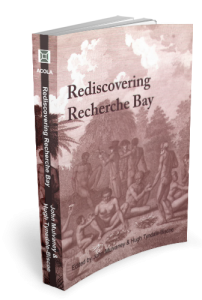National Academies Forum
Rediscovering Recherche Bay
Edited by John Mulvaney and Hugh Tyndale-Biscoe, 2007
 Beautiful Recherche Bay, in southwest Tasmania, came to prominence only recently, buts its significant for Australians goes back more than two centuries. It was there in 1791-1793 that many of Australia’s unique plants were collected by botanists for the first time; a joyous encounter occurred between visiting French explorers and the Tasmanian people; and critical experiments on the earth’s magnetic field were conducted by French scientists. Long forgotten, the place hit the news in 2001 with the discovery of the remains thought to be from the French expedition. A public campaign to save the site from logging was resolved through eh generosity of businessman Dick Smith, who underwrote its purchase by the Tasmanian Land Conservancy. To celebrate that outcome a symposium was held in 2007 in Hobart with experts in several disciplines exploring the historical, scientific and cultural significance of Recherche Bay. This book is the outcome.
Beautiful Recherche Bay, in southwest Tasmania, came to prominence only recently, buts its significant for Australians goes back more than two centuries. It was there in 1791-1793 that many of Australia’s unique plants were collected by botanists for the first time; a joyous encounter occurred between visiting French explorers and the Tasmanian people; and critical experiments on the earth’s magnetic field were conducted by French scientists. Long forgotten, the place hit the news in 2001 with the discovery of the remains thought to be from the French expedition. A public campaign to save the site from logging was resolved through eh generosity of businessman Dick Smith, who underwrote its purchase by the Tasmanian Land Conservancy. To celebrate that outcome a symposium was held in 2007 in Hobart with experts in several disciplines exploring the historical, scientific and cultural significance of Recherche Bay. This book is the outcome.
It begins with a review of the historical context of the French expedition, followed by assessments of its scientific contributions to cartography, botany and zoology. The French encounter with the Tasmanians is examined and its significant to later studies on archaeology and the original of language discussed. This is followed by a review of the subsequent history of Recherche Bay as a centre of whaling.
The remaining chapters deal with contemporary matters. A report on the current archaeological assessment of the stone structure purported to be the French garden is followed by examinations of the concept of place, the basis of public versus private values and the legal aspects of the controversy over Recherche Bay. The final chapters looks to the future: how best to conserve the several values represented at Recherche Bay.
Recherche Bay, Tasmania
A site of great significance in the history of science in Australia
Authors
| Emeritus Professor John Mulvaney AO FAHA CMG Australian National University, Humanities |
| Dr Hugh Tyndale-Biscoe FAA Australian Academy of Science |
| Professor Alan Frost FAHA La Trobe Uninversity, School of Historical and European Studies |
| Dr Michael Pearson University of Canberra, Cultural Heritage Management |
| Dr Gintaras Kantvilas Tasmanian Herbarium; Tasmanian Museum and Art Gallery |
| Associate Professor Stewart Nicol University of Tasmania, Hobart, School of Zoology |
| Professor Iain Davidson FAHA University of New England, Armidale, Archaeology and Palaeoanthropology |
| Professor Ian D Rae FTSE University of Melbourne; Australian Academy of Technological Sciences and Engineering |
| Dr Jean-Christophe Galipaud Research Institute for Development (IRD) Nouméa, New Caledonia |
| Dr Antoine de Biran Consultant in geophysics |
| Greg Jackman Port Arthur Historic Site Management Authority, Port Arthur, Tasmania |
| Anna Gurnhill Heritage Tasmania, Department of Tourism, Arts and Environment |
| Rufino Pineda University of the South Pacific, Santo, Vanuatu |
| Angela McGowan Heritage Tasmania, Department of Tourism, Arts and Environment |
| Joan Domicelj AM Directeur par intérim, Programme du patrimoine international, ICOMOS – Secrétariat international |
| Professor Aynsley Kellow University of Tasmania, Hobart, School of Government |
| Tom Baxter University of Tasmania, Hobart, School of Accounting and Corporate Governance |
| Professor David Lindenmayer Australian National University, Centre for Resource and Environmental Studies |
How to order a Printed Copy of the Book
Please contact ACOLA at info@acola.org.au to obtain a printed copy.







